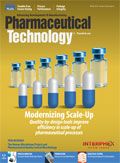Modernizing Scale-Up
Quality-by-design tools improve efficiency in scale-up of pharmaceutical processes.
Maria TouToudaki/Getty Images

Quality-by-design (QbD) methods, which focus on using science- and risk-based approaches to design a process, are increasingly being used in pharmaceutical process development and scale-up. A goal of QbD was to reduce regulatory burden and allow continual improvement within a design space. FDA is incorporating QbD concepts, for example, in its question-based review for new drug applications (NDAs) and abbreviated NDAs (ANDAs). Professionals at a growing number of pharmaceutical companies are finding that QbD-based strategies are more efficient and help achieve the goals of getting products to market faster with less expense, reduced risk, and more consistently high quality.
QbD reduces risk
In the small-molecule drug-substance market, a trend toward outsourcing chemical development and early-stage manufacturing has created new requirements for streamlined technology transfer between companies and sites, note Steve Cropper, business development manager, and Joe Hannon, CEO, both at software provider Scale-Up Systems. “When you start to hand over reaction, workup, and isolation steps to be run at scale, often in different geographies, making a robust assessment of what is going to work becomes a priority,” explains Cropper. QbD tools allow an increased understanding of the process, which leads to a more robust and reliable process with reduced risk for scale up. “Application of QbD tools enables practitioners to ‘hit the sweet spot’ quickly,” adds Cropper. “So, even though chemistries may be getting more complex with more steps to scale-up, the right tools are enabling users to find the conditions where they can run their processes to achieve their critical quality attributes (CQAs).” This holds true for both drug-substance and drug-product manufacturing.
“A change in scale-up strategy is identifying, characterizing, and focusing on scaling up the key drug product attributes rather than by scaling up process parameters using conventional scale-up principles,” notes Preetanshu Pandey, senior research investigator at Bristol Myers Squibb. “This strategy ensures more confidence on scale-up that, in turn, enables more development work to be conducted at small scale (i.e., minipiloting), leading to significant API savings,” says Pandey. “A part of the reason such a strategy is now possible is the introduction of new process analytical technology (PAT) tools that can provide that level of characterization, in addition to an enhanced understanding of relevant drug-product properties or key process factors that directly affect CQAs.”
“By enabling advanced process understanding, QbD reduces the risk of batch failure or the need for rework when changes are made,” says John Groskoph, senior director, global chemistry, manufacturing, and controls at Pfizer Global Supply. “When we understand our processes more thoroughly, we are better positioned to anticipate potential risks to product quality. The concept of connecting the attributes of the finished drug product back to the quality target product profile and, ultimately, to patient needs, is the foundation for any QbD program. Challenges do remain, however, particularly with how to use enhanced process understanding to enable post-approval changes in ways that may differ from established regulatory guidance.”
QbD approaches are increasingly used to provide a greater assurance of scale-up success with less need to troubleshoot or redesign after failure at a larger scale, says Christopher Potter, International Society for Pharmaceutical Engineering advisor and chemistry, manufacturing, and controls consultant. Using QbD approaches that incorporate a quality risk management (QRM) methodology reduces risk and facilitates scale-up. QRM involves risk identification, analysis, and evaluation to produce parameters that can be investigated to enable risk reduction in the formulation and in the process design, Potter explained in a webcast on scale-up using QbD (1). A multi-functional team (i.e., scientists, manufacturing personnel, engineers, quality assurance personnel) is crucial for QRM, said Potter, because these experts can identify the risk factors, particularly those important to scale-up, during the development phase, rather than later. The team analyzes the process using tools such as fishbone diagrams to identify CQAs and potential critical process parameters (CPPs). QRM tools (e.g., failure mode and effect criticality analysis) can be used to produce matrices to show the relative risk of each CPP on relevant CQAs. Designed experiments are conducted on the high-risk factors to try to reduce risk, and the team reiterates the risk assessment if necessary. “As evidenced in public presentations, QRM techniques are widely used by both innovator and generic companies,” Potter told Pharmaceutical Technology. “There seems to be increasing use, encouraged by regulators, with, for example, the question-based review process operated in the US for generic product ANDAs.”
Faster test results speed decisions
PAT using online, inline, or at-line methods produces real-time results, which reduces time in scale-up experiments because decision makers don’t need to wait for off-line laboratory results before making adjustments. In addition, real-time data are more useful for troubleshooting and understanding what is happening in the process. “Rather than simply knowing that a batch failed, you know why it went wrong,” explains Emil Ciurczak, principal at Doramaxx Consulting. “The constant flow of information also helps you continuously improve your process.”
A PAT machine-vision imaging tool for inline particle characterization can show processors, in real time, whether they are obtaining the properties they expected at scale-up. “Imaging can be used to ‘fingerprint’ a product for scale-up,” explains Luke Kiernan, technical services director at Innopharma Labs. “You can take images of spheroids or granules at a 2-kg scale, for example, and look for the same particle size and morphology at a 100-kg scale.”
Modeling
The speed and quantity of data collection from PAT, as well as high-throughput experiments and design of experiments (DOE) programs, while beneficial, can present a quandary. “A challenge for customers is to avoid drowning in a sea of experiments and data, especially when much of the data are not informative or important,” says Cropper. Multivariate data analysis software can be used to help identify which variables are important, particularly when the impact of scale-up on a process is not as well understood or is complex, as is often the case in biopharmaceutical process modeling.
Using mechanistic, first-principles modeling, however, should be the first choice if possible, and software is available to help scientists and engineers apply fundamental principles without having to directly handle the math, says Cropper. In API manufacturing, for example, “Modeling software can quantify the effect of scale-dependent physical rates (e.g., mixing and heat transfer) on scale-independent chemistry (e.g., the rates of the main product and impurity-forming reaction steps) as well as crystallization and isolation. Linking these rates in a predictive model enables the scale-up and technical-transfer groups to visualize whether they will get the results they expect on scale-up and to select, or specify, the best equipment for their API steps. In short, it enables more confidence that scale-up will be successful in today’s accelerated development programs,” he concludes.
Modeling technologies enable process engineers to simulate changes in the process model and develop an optimized process and control strategy without running experiments on the actual process. This strategy saves time and cost.
Flowsheet models are process system engineering tools that can be used to improve control strategies and product quality for continuous manufacturing processes, note the authors of “Flowsheet Models Modernize Pharmaceutical Manufacturing Design and Risk Assessment,” in this issue of Pharmaceutical Technology (2). Because the equipment in a continuous manufacturing process is integrated in an end-to-end fashion, understanding the relationship each piece of equipment has on the product is not a trivial problem. Understanding the impact process variations have in the output of the system is crucial for quality control and risk management. Flowsheet models use the individual mathematical models for process equipment to create a model representation of the integrated continuous process in order to study the system in silico. Using flowsheets, the impact of process disturbances on the product properties can be simulated, which allows quantitative risk assessment and development of effective control strategies. Flowsheet models can be used for the design, control, scale-up, and assessment of continuous processes and can also help translate batch processes into an integrated continuous process.
Continuous processing
Continuous processing is being developed for API production, drug-product manufacturing, and, in some cases, for end-to-end production with no break between.
“Continuous manufacturing is the way of the future,” says Ciurczak. “Drug pricing pressure is pushing manufacturers to modernize to reduce costs, and industry has reached the tipping point for using continuous processes-NDAs using continuous processes have been approved and equipment is commercially available for anyone to purchase.”
Optimizing a continuous process with DOE uses much less material than DOE in a batch process and can be performed more quickly, because process conditions can be changed relatively quickly. Continuous processes are easier to scale than batch processes, and, in fact, can eliminate the need for scale-up at all because the process could, theoretically, be run for a short time to obtain a small-scale volume or a longer time to obtain a larger-scale volume, with both scales using the same equipment and processing conditions.
References
1. C. Potter, “Strategies for Successful Scale-up Using Quality by Design,” Webcast (Mar. 27, 2014).
2. M. Escotet-Espinoza et al., Pharm. Tech. 39 (4) 34-42 (2015).
Article DetailsPharmaceutical Technology
Vol. 39, No. 4
Pages: 28-32
Citation: When referring to this article, please cite it as J. Markarian, “Modernizing Scale-Up,” Pharmaceutical Technology39 (4) 2015.
